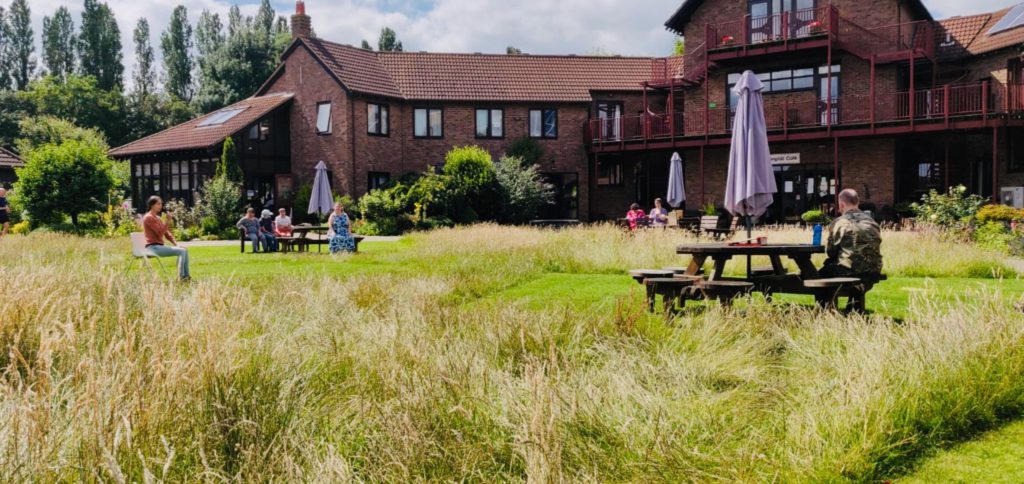When I started working in Camphill, a community of adults with learning disabilities, I could not imagine that the residents would ask me to do meditation twice a day. However, it took me a while to find out the right way for engaging them in meditation.
I first tried to impart the style of meditation I know the most, vipassana. I adapted the wording and exercises to their cognitive abilities. However, although a few people did engage, others would rather fall asleep. Therefore, I always tried to keep the meditation no longer than 10 minutes so that everybody could stay awake during the whole session.
One day, when meditation already became a part of the new lock-down schedule, somebody played a meditation recording with a very calm music on the background. I was amazed to see that they all stayed seated for almost 20 minutes despite the hypnotizing tone of voice of the woman who was leading it. What was the secret for this success?
During this meditation, they were guided to the sea, the place where they would meet a whale and dive deep into the ocean. They were also led to awaken the feeling of amazement for being able to breathe under water. At the end, they had some time to explore the depths of the ocean on their own while being hold by the peaceful music on the background. Any sense of threat was attenuated, and the guiding voice promoted feelings of security, unconditional acceptance of their being, and love.
This inspired me to adapt my meditations to prevent them from falling asleep and keep them engaged during the whole meditation session. After a few weeks, these were the adjustments I incorporated into the practice that proved to be positive for their meditation experience:
- Start by doing a few gentle stretching or chi-kung exercises. In this way, you are creating an atmosphere of relaxation while keeping the body active and awake. Some of them may have difficulties on sitting straight, so back stretches can help them improve their posture. After a while, ask them to follow the breath with the movement so they can start gaining some focus and anchoring the mind into the body and the breath.
- Explain at the beginning what you will do in the meditation. When I was doing vipassana-style meditations, I always told them that we were going to open fully our senses to have an ‘enhanced’ experience of the world. With the time, I realized that some people didn’t know what the five senses were. Thus I had to explain to them what those were and help them realize the different sensations we receive through the senses. Some were amazed to discover that they could perceive a table through their eyes but also by touching it. So, explain them always what you’ll do, and in case of doubt about their understanding, starting with the basic concepts is always a good idea!
- Let them use their imagination or try to create a ‘story’. People with learning disabilities love to imagine. They also have a very rich imagination capacity and love feeling a part of a story. If you let them imagine something, describe it in as many details as you can. However, let them also fill some of the gaps. For example, you can make them imagine that they are in a beach and that they meet a mermaid on a rock. You may describe some aspects of the mermaid, for example, that it has a shiny, blue tale and very big eyes… but then ask them questions to get them engaged in the story. For example, ask them ‘what is her name?’ or ‘what’s the colour of her hair?’. You can use different characters to accompany them to go somewhere where they feel peaceful, calm and safe. Then let them explore these feelings on their own. I found that they become more engaged with this inner exploration of peace when they feel that it is all part of a story in which they are participating in.
- Use visualization exercises. In a meditation practice, we would normally say: ‘If any thoughts appear, just observe them and let them go away’. However, people with learning disabilities might have difficulties to do such an abstract mental exercise. It is therefore better to let them visualize a concrete image to achieve a similar purpose. For example, you could say: ‘Imagine that your thoughts are like coloured balloons… whenever you find one, observe it and then release it. Watch how it flies away up to the sky and gradually disappears.’
- Try to use a specific meditation space. If you can, create a nice space with a calm atmosphere only for the purpose of meditation. In this way, they will feel like they were doing something special. That will encourage them to give themselves more fully to the practice. Meditation outdoors is also helpful, especially when using vipassana-style meditation. It gives them a wider scope to explore a variety of sensations.
- They don’t mind repeating always the same! An amazing thing that I discovered with them is that it does not matter if you repeat many times the same story or the same exercises of visualization. Actually, the more they repeat the exercise, the more confident they will become, and the better they will feel. They are always amazed at the results of the meditation, regardless the techniques you use.
I hope that you found this article helpful and you enjoy doing meditation with people with learning disabilities. If you try it, you’ll discover that people with learning disabilities are naturally talented to connect with their inner nature. So don’t be afraid to try! 😉
If you want to start a journey towards yourself, join our online self-development program, and download our Mind stories app.


